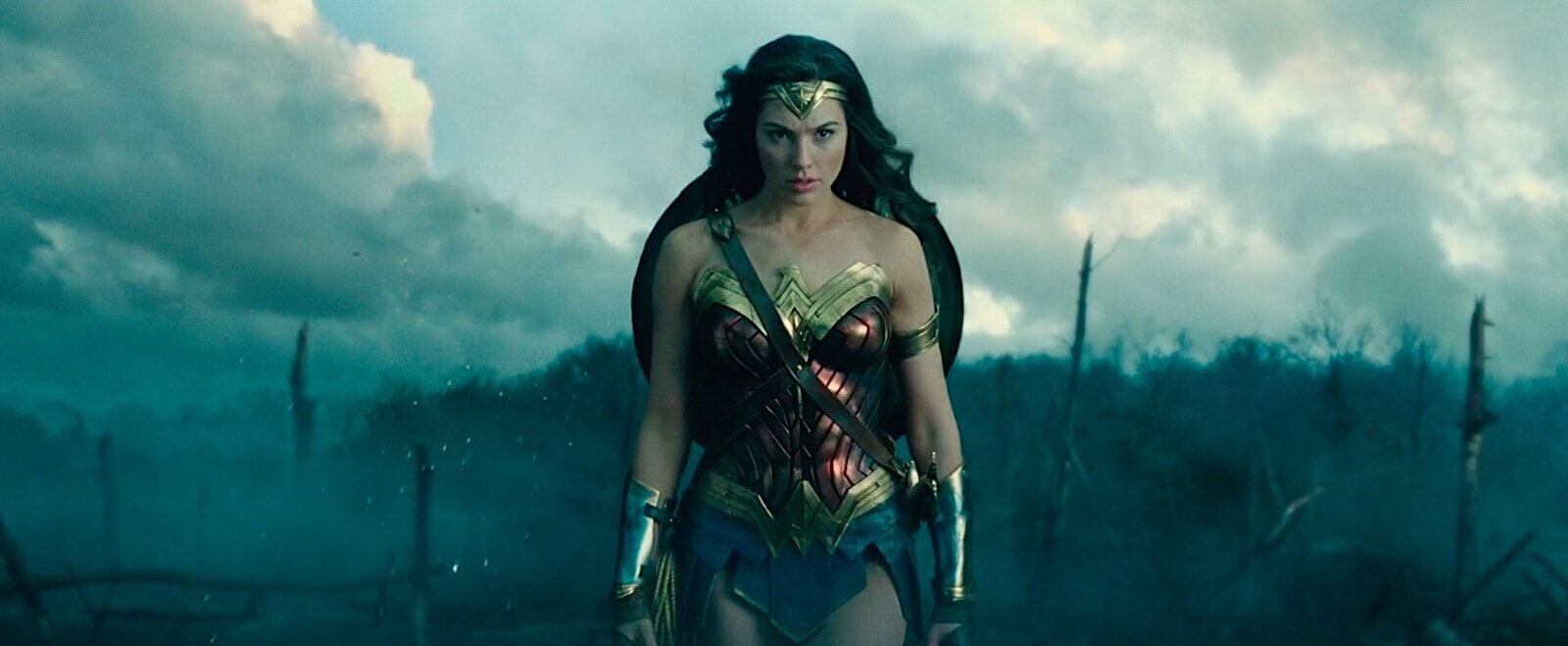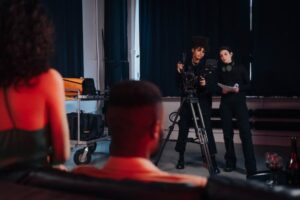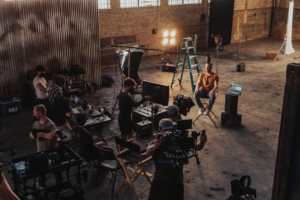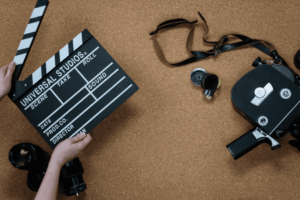A cowboy shot is a type of camera shot that frames the subject from the knees or mid-thigh to just over the top of the head. To get this kind of shot, many camera operators position the camera at hip level rather than at eye level.

Scene from “A Fistful of Dollars“
Cowboy shots can be ideal for depicting characters as confident and heroic while zeroing in on critical actions, such as drawing a weapon. Since cowboy shots are relatively close, they can reveal the actor’s emotions, such as fear or vulnerability. This duality makes cowboy shots compelling in a wide range of films.
Modern Cowboy Shots in Film
Also known as the American shot, the cowboy shot originated in Western films. Legendary Western filmmaker John Ford pioneered the cowboy shot in movies like “Stagecoach” and “The Man Who Shot Liberty Valance.”
Traditionally, this shot framed a cowboy with his gun and holster. In more contemporary films, a cowboy shot can reveal a much wider range of characters. Some of the most iconic examples of modern cowboy shots include films like:
Pulp Fiction
Samuel L. Jackson faces off with Frank Whaley in “Pulp Fiction.” This cowboy shot’s low angle gives Samuel L. Jackson’s character additional authority while keeping his gun in the frame.

Scene from “Pulp Fiction”
Wonder Woman
Gal Godot strikes a confident pose in “Wonder Woman.” Here, you can see Gal Godot’s character as a strong, resilient heroine and her trademark lasso at her hip.

Scene from “Wonder Woman”
Fight Club
Brad Pitt smokes in “Fight Club.” This modern take on a classic cowboy shot shows Brad Pitt’s character at his most confident, and you might even suggest his holstered weapons are his hands at his hips.

Scene from “Fight Club”
In another scene, Brad Pitt stands next to Edward Norton, and this cowboy shot highlights the differences in the two characters rather than depicting a confrontation.

Scene from “Fight Club”
The Dark Knight
Gary Oldman stands on his own in “The Dark Knight.” This framing choice sets up Gary Oldman’s character as a renegade rather than part of the group.

Scene from “The Dark Knight”
Shots Showing Camera Angle or Placement
Many of the most common shots indicate where the filmmaker has placed the camera, which is helpful for aspiring filmmakers eager to learn. These shots can also reveal key information about the characters’ mental or emotional states for the audience.
Eye-Level Shot
As one of the most neutral framing options, this type of shot shows the scene from a typical human eye level.
Low-Angle Shot
Filmmakers create low-angle shots by positioning the camera below the subject. Because these shots look up at the subject, they often instill the character with power.
High-Angle Shot
To take a high-angle shot, filmmakers position the camera above the subject. Since it looks down on the subject, it can add a sense of fear or weakness to the scene.
Aerial Shot
To create aerial shots, filmmakers take to the sky, often with drone-mounted cameras. These shots typically establish the location for the film.
Bird’s-Eye Shot
Also known as a top shot, this framing method shows the subject from directly overhead. It also includes part of the setting to add more context to the scene.
Over-the-Shoulder Shot
For this type of shot, the camera frames the subject from over the shoulder of another character. It appears most frequently in scenes with conversations and personal connections.
Dutch Angle
For a Dutch angle shot, the filmmaker places the camera at an angle. As a result, the scene looks askew and suggests disorientation.
Handheld Shot
For handheld shots, filmmakers hold the camera, effectively inviting viewers into the scene.
Crane Shot
With the camera on a crane, filmmakers can move it vertically. Crane shots often appear at the end of movies.
Dolly Zoom
For this type of shot, the camera moves toward the subject while zooming out at the same time. Dolly zoom shots are often designed to disorient the viewer.
Camera Shots Showing Subject Size
Like cowboy shots, many framing techniques show the subject’s size in a unique way.
Close-Up
With a close-up shot, the subject’s face usually fills the frame. This type of close framing keeps the viewer’s attention on the character, including their emotions and reactions.
Long Shot
Also known as a wide shot, this framing method highlights the entire subject with slightly more detail than an extreme long shot. It also shows the scene’s setting.
Medium Shot
In contrast to a long shot, a medium shot frames the subject more closely and has more detail. Most medium shots show the subject from the waist up and include some of the environment.
Full Shot
For this type of shot, the subject fills the frame, with the head near the top and the feet near the lower edge. This framing method often works best for action shots.
Medium-Long Shot
Similar to a cowboy shot, a medium-long shot shows the subject from the knees or mid-thigh up. Instead of showing the subject as confident or heroic, a medium shot can reveal a wider range of character types and emotions.
Medium Close-Up
A medium close-up strikes a balance between a close-up and a medium shot. It usually starts at the chest or shoulder and focuses on the subject’s face.
Extreme Long Shot
This shot shows the subject from far away. It establishes the scene and reveals how the character relates to the environment on a physical and emotional level.
Extreme Close-Up
An extreme close-up gets even closer to the subject than a standard close-up or a choker. For an extreme close-up, the camera usually focuses on the eyes.
Choker
A choker takes a close-up shot to even more extremes. It often frames the subject from the forehead to the chin and focuses closely on the subject’s expressions and emotions.
Other Camera Shots You Should Know
If you want to get creative, you can choose from almost two dozen other camera shots.
Arc Shot
An arc shot uses the camera to circle around the subject.
Bridging Shot
This shot documents a change in time or environment.
Cut-In Shot
These shots cut from the subject to a close-up of the scene and then back.
Cutaway Shot
Cutaways cut from the subject to another object or scene and then back.
Deep Focus
A deep focus shot maintains sharp focus on the fore- middle-, and background.
Establishing Shot
This type of framing appears at the beginning of the shot and sets the scene.
Library Shot
Also known as a stock shot, a library shot includes a preexisting scene.
Locked Down Shot
For a locked-down shot, filmmakers fix the camera in position as the action happens outside of the frame.
Master Shot
A master shot shows an uninterrupted view of the scene and is usually a full or long shot.
Matte Shot
Matte shots show action in the foreground against a set background.
Money Shot
Money shots tend to make a big impact and cost a lot to produce.
Pan Shot
A pan shot tracks horizontally.
Point of View Shot
A POV shot shows what the subject observes and puts the viewer in their shoes.
Reaction Shot
This type of shot reveals the subject’s response to the previous shot.
Reverse Angle Shot
This shot offers a 180-degree difference in perspective from the previous shot.
Sequence Shot
This type of long shot shows the whole scene in one movement, with no cuts.
Steadicam Shot
These shots use a Steadicam to reveal smooth movement during a scene.
Tilt Shot
Essentially a vertical panning shot, a tilt shot moves up to down or vice versa.
Tracking Shot
Tracking shots move with the subject, often from behind or alongside.
Two Shot
This type of shot includes two subjects.
Whip Pan Shot
A whip pan shot pans quickly through a scene, often creating a blurry effect.
Zoom Shot
A zoom shot zeroes in on the subject without requiring the camera to move.
Becoming a well-rounded filmmaker starts with knowing the best techniques used in the industry today. Apply for the Cinema Production Diploma at Nashville Film Institute to begin your career.












